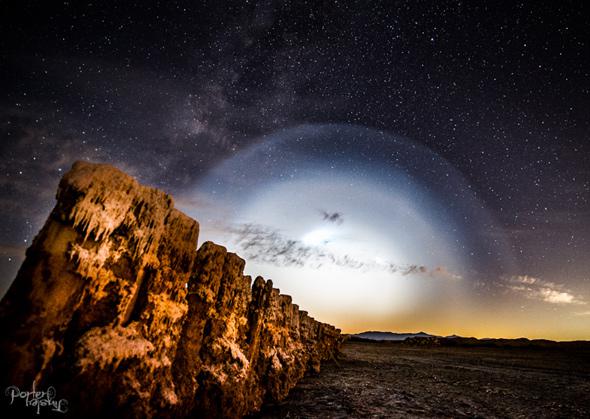Last weekend—on Saturday—a mysterious bright fan of light swept across the sky on the U.S. West Coast. It was seen by perhaps hundreds of thousands of people, many of whom, understandably, were pretty flipped out by it.
It was quickly determined to be an unarmed Trident II missile test launched by a submarine in the Pacific. The missile is a three-stage affair; when one stage burns out, a small explosion is triggered, which separates it from the rest of the missile, the next stage ignites, and off it goes again.
Update, Nov 10, 2015: The Navy has released some interesting photos and descriptions of the test.
The staging event is what made a lot of people wonder what the heck they were seeing; once the missile is above most of the atmosphere that gas expands in a ring, and if it’s up high enough, it’s lit by the Sun for all to witness.
My Twitter stream lit up about this as well, and I got a couple of people pointing me to a photographer, Porter Tinsley, who was taking photographs on the shore of the Southern California Salton Sea at the time. She caught the missile at the perfect time and took some fantastic shots of it. Here’s an animation of them; it takes a bit of explaining so see below.
She was facing almost due west for these photos (if you look carefully you can see the star Vega near the top of the shots on the right, and Altair to the left). Since the action is on the horizon, the missile must have been a few hundred kilometers away. I’ll note that a Pentagon statement says it was headed toward Kwajalein Atoll in the south Pacific, a usual target. However, in every video I’ve seen the missile moves left to right; for a viewer facing west that means it was heading in a northerly direction. I’ll be curious to see how this is resolved.
From Tinsley’s photos it almost looks like the missile explodes, but that’s not real: She was taking short exposures at first, then started taking far longer ones. Jumping from a fraction of a second to 13-second long exposures makes things much brighter!
It looks like she caught the expanding cloud of gas from the staging event not long after it started. I can’t be sure from her pictures, but it almost looks like I can see a faint spiral arm pattern to it. That can happen if the ejected booster starts spinning, blowing out gas. It gives the venting material a water-sprinkler effect, an expanding spiral pattern. This has been seen before in the famous Norway Spiral, the most dramatic example I’ve ever seen.

Photo by Porter Tinsley, used by permission
In the last few frames, to the lower right of the blue cloud, you can also see the orange glow from … well, something. It may be the ejected stage; it appears to have at least one and maybe two faint fans of material coming out of it. The long exposures blur the effect, so it’s hard to say. Still, it’s very cool.
I’ll note that I received hundreds of Twitter responses to this, and some people were arguing about it. Many were questioning whether this was really a missile launch, for example. Yes, it was. I won’t bother delving too deeply into conspiracy theory nonsense; we have plenty of footage of what a missile launch at night looks like once it’s dozens of kilometers off the ground, and this was that.
Other people wonder why they were testing a missile at all. Well, that’s no surprise: This technology is complicated, and it’s a pretty good idea to give it a run-through every now and again. Conditions change, weather changes, the circumstances where you might have to use this missile change, so testing it is sound military thinking. Why they did it when they did, when so many people would see it, is a different question. It may have been a simple matter of logistics; depending on where they have certain assets that can watch the test (radar stations and the like) and report back.
A lot of people were pretty unhappy the Navy didn’t announce it beforehand, but hello. It’s a test of an intercontinental ballistic missile. There are bad guys out there, so why give them any notice and make it easier to scrutinize this better?
Look, I’m no fan of war, nuclear or otherwise. You won’t find me beating the drum to march off; I grew up during the Cold War and had nightmares about nuclear annihilation. But those bad guys do exist, and while you might argue over how much we spend, how we spend it, and all that, I do hope we can all agree that we do need to defend ourselves if necessary. I hate that we might have to, but there are lots of things going on in the real world that I’m pretty unhappy about. Better to accept that they exist and figure out what to do about them than pretend they don’t, and find out how big a mistake that was later.
